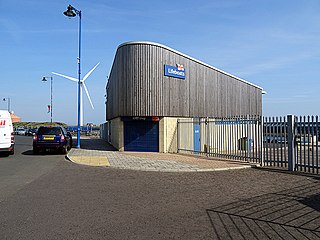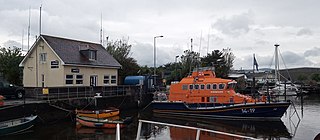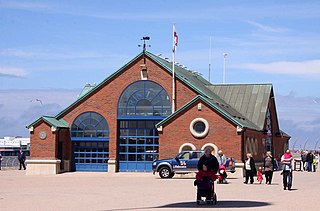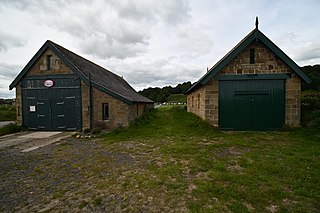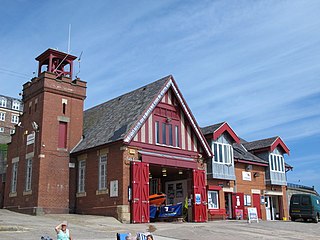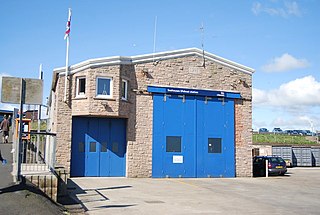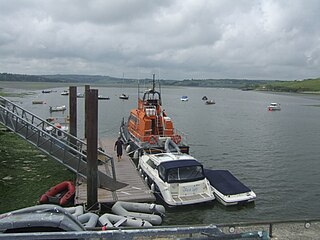History
A station was opened at Boulmer in 1925 under the management of the Newcastle Shipwreck Association (NSA), following a request by Mr. William Clarke to the (RNIPLS) for a lifeboat. A boathouse was constructed by the NSA, and a lifeboat was duly provided, a 27-foot 6in 10-oared North Country, or "Greathead", type lifeboat, built by Thomas Wake of Sunderland. [2]
This first Boulmer lifeboat would serve 27 years, and save 32 lives. On 2 November 1844, the Boulmer lifeboat made three trips to the wreck of the Iris and would rescue 8 men. Lt. John Brunton, RN, of H.M. Coastguard was awarded the Silver Medal. [3] [4] [5]
In 1851, the Boulmer boat was reported as being in poor condition, and a request was made of the RNIPLS to provide a replacement. A 30-foot self-righting lifeboat built by James Beeching of Great Yarmouth was provided, at a cost of £130. It was funded by Algernon Percy, 4th Duke of Northumberland, and was named Prudhoe, the Duke having formerly been known as Lord Prudhoe. [2]
In 1853, Boulmer Lifeboat Station would be transferred to the management of the RNIPLS, which became the RNLI the following year. [1]
Prudhoe(I) didn't serve long at Boulmer. The boat was disliked by the crew, and a second replacement was requested. This time, a 30-foot 10-oar self-righting boat was supplied by Forrestt of Limehouse, London, arriving in Boulmer on 30 November 1854. This time costing £150, it was once again funded by the Duke of Northumberland, and was again named Prudhoe. Whether the boat was no good is up for speculation. It capsized when being towed back to Newcastle, but then went on to serve at Thorpeness, Newhaven and Fishguard, in service until 1885. [1] [2]
On 13 March 1913, in a severe gale, heavy seas, and dense fog, the French steam trawler Tadorne of Boulogne with 30 crew ran aground near Howick Haven. Three men tried to make shore in the ships boat, but two were drowned. The rest of the crew clung to the rigging, as large waves crashed over the boat. On surveying the scene, Albert Grey, 4th Earl Grey of nearby Howick Hall despatched a messenger to raise the Boulmer lifeboat. After an extraordinary effort, and two trips, the Boulmer lifeboat managed to save 25 men off the trawler. Coxswain William Stephenson was awarded a Gold Medal from the French government, the RNLI Silver Medal, and two awards from the French Lifeboat Service, Societe Hospitaliers Sauveteurs Bretons. The wreck of the steam engine is still visible today. [2] [3] [6]
A Clayton launch and recovery tractor was trialled at Boulmer in 1922, but with little success. An article in "The Lifeboat" magazine of 1926 highlighted that some 115 people of the village Boulmer, around 80%, could be involved in the launch of the lifeboat. As a result, the women lifeboat launchers were awarded The Thanks of the Institution inscribed on Vellum. [7]
In 1927, another Clayton launch tractor was placed at Boulmer, but a larger more powerful FWD Ltd tractor, T23, was trialled in 1928. The lifeboat and carriage were hauled a ½-mile across mud, and then 150 yards out to sea, launching in just 24 minutes, proving the tractor a great success. T26 was placed on service in 1930. [1]
Soon afterwards followed a motor-powered lifeboat. L. P. and St. Helen (ON 703), a 35-foot 6in Self-righting motor lifeboat built by S.E. Saunders of Cowes, so named after her benefactors, Miss Ann Lovelock, Mr A H Pett, and Miss Helen Turner, arrived in Boulmer in 1931. [1] [2]
In 1967, it was decided to withdraw the All-weather lifeboat from Boulmer. The boat was formally withdrawn on 31 March 1968, replaced on 1 April with an Inshore D-class (D-100) lifeboat on station for a 1-year trial. With only two service launches, and no lives saved, the D-class was also withdrawn at the end of the summer season. After 143 years of service, 199 service launches, and with 236 lives saved, Boulmer RNLI lifeboat station closed at the end of 1968. [2]
1969 saw the foundation of the Boulmer Volunteer Rescue Service.
The former RNLI boathouse was given over to the rescue service, which is still in operation to this day. [2]



